Over the weekend, we experienced Porsche’s fantastic new 911 GTS ahead of its world debut this week in LA. Over the course of the three day affair, we learned quite a lot about Porsche’s newest 911. For starters, we learned reasons the GTS is one of the best deals in Porsche’s current lineup, we learned why you should consider one, and we learned about what makes the GTS different from a Carrera S. Here’s more of what we learned in no particular order.
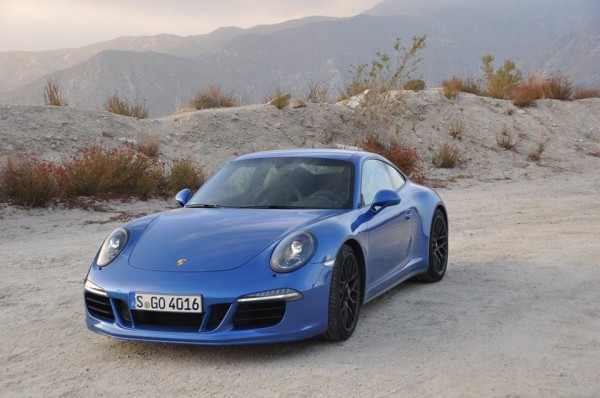
1. Why the 991 GTS is better than a highly optioned Carrera S:
If you take a look at the specification sheet, the GTS models, on paper, are essentially Carrera S and C4S models equipped with all of the best options as standard, plus some bespoke trim. In reality, all of those options just work so well together that the GTS stands head and shoulders above a stripped out Carrera S that Porsche is pretty validated for giving it a new model name.
The GTS comes standard with a number of items that are optional on the Carrera S, including Porsche Bi-Xenon Headlights with PDLS ($1515), PowerKit ($17,800), Sport Exhaust ($2950), Sport Chrono ($1850), and PASM ($890) chief among others. To spec a Carrera S up to the same level as the GTS, you would easily spend more than $25,000 in options, but the GTS only holds a $16,295 premium over its little brother. On top of the stuff that you can get optional on the Carrera S are a number of pieces that you cannot get, including the 20″ center-lock wheels cribbed from the Turbo S, the black exhaust tips, the black-rim headlamps, the Carmine Red or Rhodium Silver tachometer gauge, and the GTS interior with Alcantara everywhere (seat centers, steering wheel, shifter, parking brake, door handle trim, and the door storage pockets).
2. Which one to buy, if you are shopping:
If you’re looking for a great street car that you could easily drive every day, the Carrera GTS Cabriolet with a PDK transmission is my personal choice, as it is the car I most connected with over my time with the GTS lineup. Personally, I really enjoy having a street car with a drop-top, as it’s only marginally worse to live with during poor weather days, but when the sun comes out and the sky is blue, it’s 100 times more fun to drive. You get a better feel for the exhaust note, you can smell the tires and brakes as you work them harder, and you can see so much more of the world. I don’t personally need four-wheel drive, and I felt slightly more in tune with the steering when I didn’t have front axles engaged. The weight distribution is slightly more traditional Porsche in a 2-wheel drive car, and I think that is part of the fun. The big thing here, however, is the PDK. I love manual transmissions, and all of my cars for the last 10 years have been manually shifted, but Porsche’s PDK is the only transmission I’ve ever driven that makes me think I would be willing to live with an automated gearbox. It only took about 2 laps around the track for me to remember that PDK was vastly more intelligent than I am, and leaving it in automatic Sport+ mode is the quickest way around. PDK allows you to focus more on your brake and throttle inputs, your lines through the corner, and your steering angle. It just allows you to have more fun, and drive the car quicker.
There are a lot of guys out there saying that they would be interested in getting the GTS, because its as close as you can get to the GT3 with a stick shift. I’ll admit, I had a whole lot of fun in a 7-speed equipped Carrera 4 GTS both on track and on the street. The 7-speed is a fantastic manual transmission, but it doesn’t hold a candle to the PDK. If you must have a stick, this is a good one to have, though. The auto-blip downshifts are fantastic, and the gates are easy to find in the more frequently used 1-2-3-4 gears. Fifth, Sixth, and Seventh gears, though, become a little more difficult to reach. There’s just something in my brain that made it difficult to move the shifter all the way to the right and up into 7th. With a lot more street time, and specifically freeway time where you would use 7th, I might get the hang of it, though.
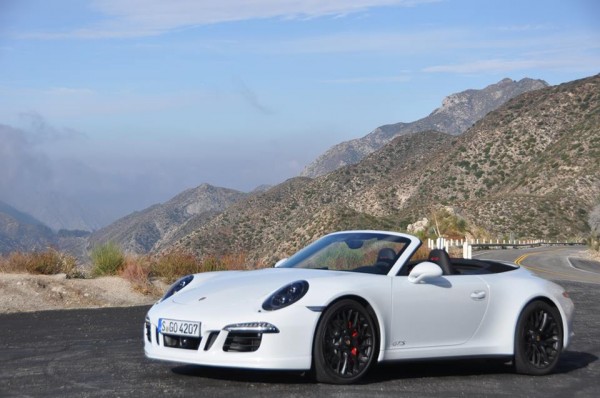
3. How the Powerkit makes its 30 extra horsepower over the standard engine:
I was curious how the Powerkit engine made its 430 horsepower versus the standard Carrera S 400 horses. Porsche gave us the opportunity to sit down with Friederich Seiler, the company’s Engine Tuning Engineering Manager. If anyone could tell us, it’d be this guy!
Seiler estimated that the Powerkit’s revised intake manifold was responsible for somewhere around 50% of the power gain, replacing the engine’s standard plastic intake for a custom made complicated dual-plenum aluminum intake. It is difficult to describe in words, but there is a large flapper at the top of the intake tract to keep the left bank separate from the right bank until higher RPM, and then a little flapper in each of the cylinder runners that opens up to take advantage of oscillating tube pressure at high RPM to provide a less restrictive flow to each cylinder above . The way it was described, it basically allows the air that is pushed back from the closing of an intake valve to flow into other open cylinders, rather than providing a pressure differential that prevents high flow from entering each cylinder unimpeded. This system is said to help promote torque through shorter intake runners at low RPM, and then when open, allows more horsepower at higher RPM. Hopefully this cutaway diagram will help.

For the other 50% of the power gain, Porsche had to get really creative. To help promote greater flow, Porsche took the standard cylinder head from the Carrera S parts bin and simply optimized it for use in the Powerkit equipped GTS. The intake and exhaust ports have both been extremely smoothed by a new process. Porsche essentially created a viscous paste, similar to a lapping compound, and they just push this paste through the tracks of the cylinder head until they are super smooth and don’t impede airflow as much. The intake camshafts were also replaced with units that provide a higher valve lift and longer duration.
4. How great the launch control is:
As always, Porsche’s launch control in the PDK equipped cars can be described as ‘neck snapping’. The coupes are said to sprint to 60 in 3.8 seconds, and the cabriolets have to make do with 4.0 second runs. We made sure to test the launch control a number of times in both a rear wheel drive cabriolet and a four wheel drive coupe, and were sufficiently impressed with their runs.
5. How great the Sport Exhaust is:
The sound of a Powerkit engine on full song with the sport exhaust button engaged is a haunting experience. When those exhaust flaps open up, it unleashes a heck of an unmistakable wail. You can hear a fantastic crackling on coast down. You can hear the glorious scream of the engine above 6,000 RPM. My favorite sound, though, is a full throttle PDK up-shift while flying along a straight at triple digit speeds.
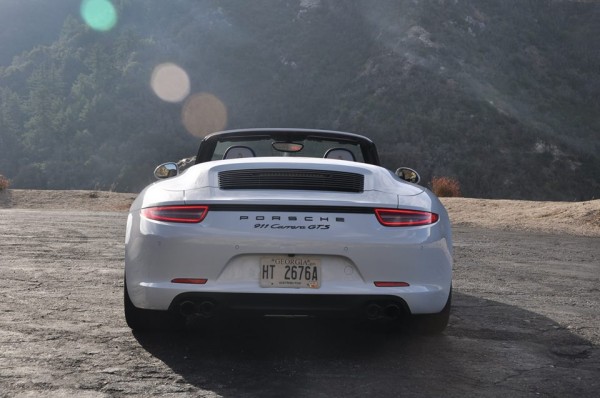
6. How quickly we can lap at ‘Big Willow’:
Our time with the Porsche Carrera GTS peaked with several lead-follow lapping sessions at Willow Springs on the famous “Big Willow” course. Porsche, with all of their fantastic resources available to them, called upon the help of 911 RSR driver Michael Christensen, and 21 year old Porsche junior driver Connor de Phillippi, as our guides driving a pair of 911 Turbo S for all of us to follow around the track.
There were a few people at the track that day that couldn’t keep up with their leaders, and it was obvious that they weren’t comfortable driving at any more than 70 miles per hour, or taking corners at more than about half a G, and frankly they had no business being at the track, and certainly could not have been learning anything about the driving characteristics of the GTS. Fortunately, we were lumped into a run group with a couple of talented journalist drivers, and both Connor and Michael gave us enough slack that we were pretty much lapping at close to full tilt, perhaps 85%.
It’s a really fun feeling to nudge the back-end to step out through the bottom of turn 5, and then run pretty much flat, getting light over the crest at turn 6, and then keeping your foot in it through the slight kink at 7, and braking into 8 from about 135 miles per hour. There is probably some more speed out there to be had with a more talented driver at the wheel, but that was pretty close to everything I could squeeze out of it.
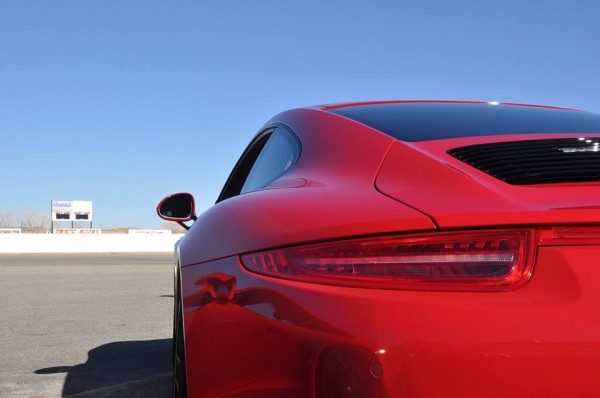
7. It’s the perfect car for Angeles Crest Highway:
As great as the 991 GTS was at the race track, its home is really on some back country roads. We were the loosed dogs, and we were chasing after an imaginary hare. For most of our driving, we were quite alone in the world, just us and the GTS. During the week, Angeles Crest and the surrounding areas are practically devoid of any kind of traffic, and it’s possible we exceeded the posted speed limits a time or two, but I can’t be certain. It was probably the best long drive I’ve ever been on in a Porsche, as we had a beautiful Carrera White Metallic cabriolet to take us up and down the mountain on the way to the track, and an even prettier Sapphire Blue Metallic Carrera 4 GTS Coupe for the drive back.
The GTS, with all of its insanely comfortable and highly detailed interior work makes for a really good long-distance GT car, but when you really want to get up on the wheel and cane the thing, the Sport comes out to play. These days, I think that’s really what GTS is all about. It’s a dual purpose car. It’s more capable than a Carrera S, and will provide a bit more fun, but on the flip side of the coin, the GTS is infinitely more usable as a road car than something like a GT3. If you think of it as a GT3 that’s been toned down a bit in deference to street usability, you’ve kind of got the idea.
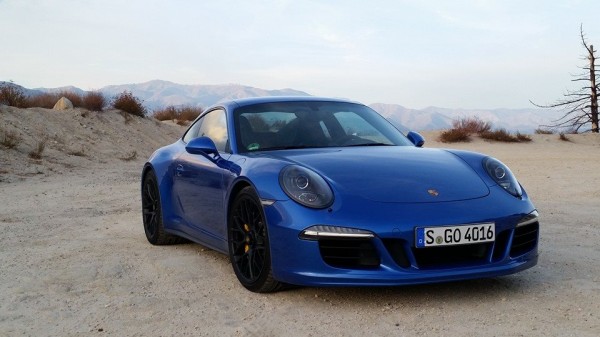
8. Centerlock wheels are cool:
They just are, and that’s a fact. The center lock wheels used on the GTS models are beautiful black pieces of kit that frame the brake rotors extremely well. As they are essentially take-offs from the Turbo S, the GTS has a decent bit more rubber under its arches than the Carrera S does. If you aren’t comfortable with center-locking wheels and the trade-offs that are made in order to have them, you can get traditional 5-lug wheels as a no-cost option, but you’re stuck with the narrower wheels from the Carrera S as well. If you’re going to have the wide fenders, you might as well fill them with as much rubber as possible, right?
9. The GTS Alcantara interior is the best interior Porsche has ever offered:
There is something to be said for a good interior, and Porsche has really figured it out with this 991. I am 6’1″ and not exactly small around the waist, so I’ve always felt a little cramped, but the 991 is just big enough to make for an excellent long-term cruiser for those of us in the “big-and-tall” set. One of the cars that I had the opportunity to try out for quite a while was equipped with the 18-way adjustable buckets and the full GTS Alcantara package. If you do opt for that package, I suggest you get the Carmine Red interior accents, as it just looks great with a big red center-tach gauge, and red stitching accents everywhere. Great stuff, and worth every dime (easy for me to say when I’m spending your money).
If someone at Porsche’s after-sales department would like to hook me up with a set of the 4-way adjustable sport-seats with GTS Alcantara trim, I would be more than happy to have a set for our Project Boxster Clubsport. Goodness those things were comfortable and provided excellent cradling support through corners.

10. It’s the subtle differences that make it better:
The GTS is about subtle differences that help it eclipse the Carrera S in every way, shape, and form. From the outside, you can instantly tell this Porsche is built for business with its wide haunches, equally wide rubber, center lock wheels, and black accents. Even in a subdued color like the dark blue 4 GTS I drove, it looks menacing and sinister. Inside, it’s about as comfortable as a sporty car can be, but still doesn’t let you forget that you’re in a 911.
Other than visually, the car is also dynamically superior, of course aided by that wide rubber and wide track stance. The front bumper is said to be aerodynamically superior to the Carrera S bumper, and to offset that at the back, the GTS’ rear decklid dynamic wing comes up at a sharper angle of attack than the same one found on the Carrera S. It drives really well, keeping a much more neutral handling balance than previous iterations of the 911, though there is still a hint of oversteery demon lurking under the skin if you really provoke it. It leaves nothing on the table when you ask it to give its all. At the same time, Porsche’s new 991 GTS asks everything of the driver, and you’ll gladly give it.
Other Porsche Blog Posts You Will Enjoy
Porsche’s New Carrera GTS Lineup Bridges The Performance Gap Between S and GT3
Pricing, Pictures and Specs Of The New Base Cayenne and GTS
Why A Pre-Owned Porsche Is The Perfect Entry Level Strategy
Porsche 918 Spyder Vs. McClaren P1. Which Is Faster?
Road & Track Name Porsche’s 991 GT3 2015 Performance Car of The Year